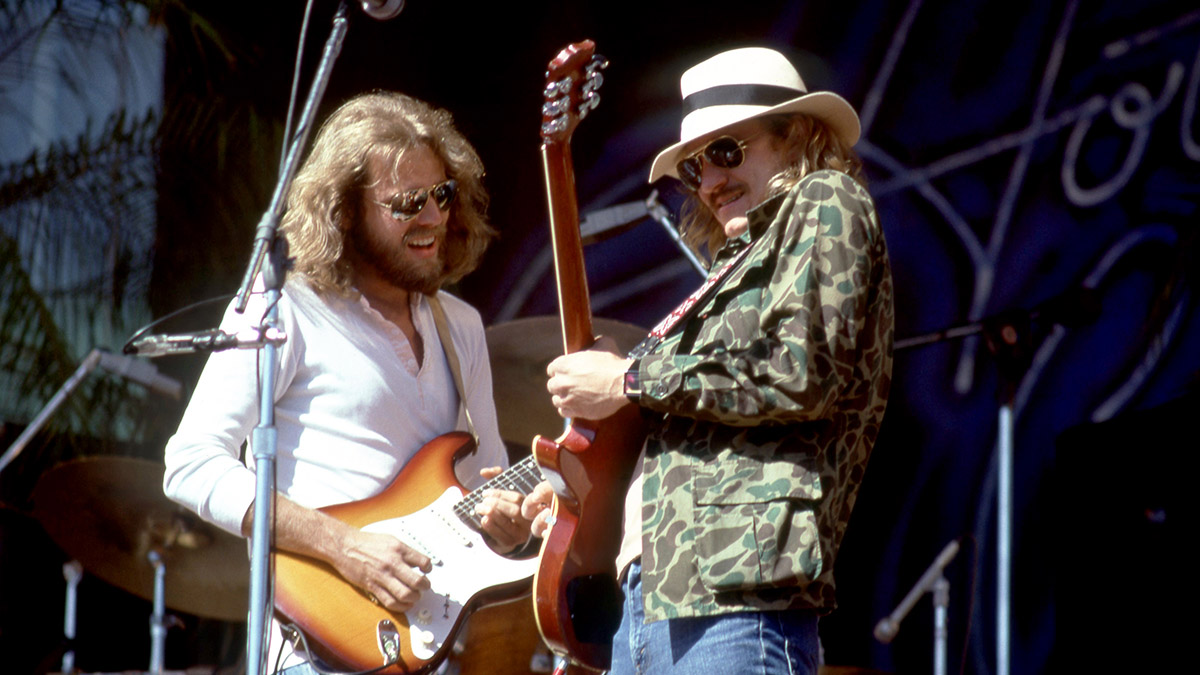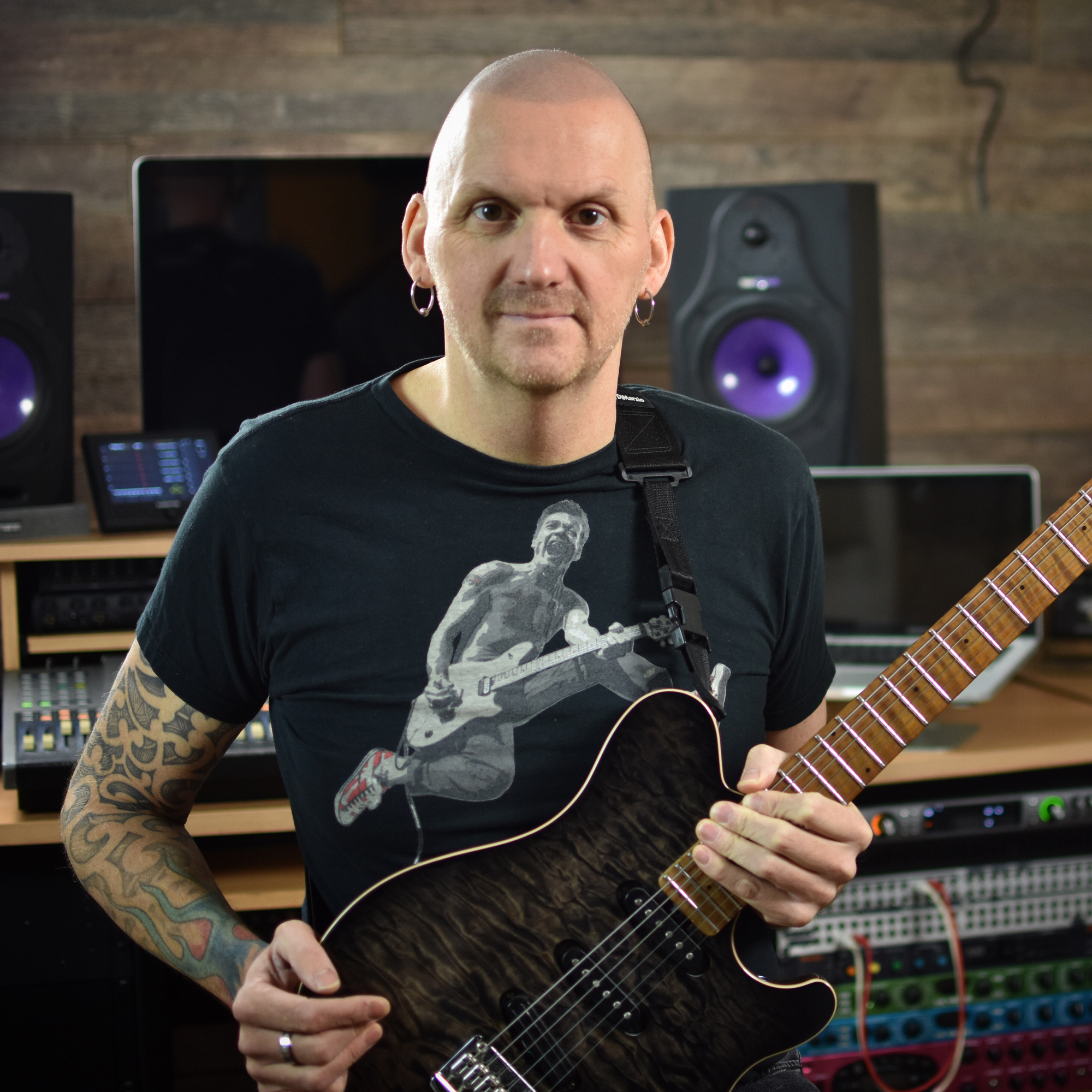The Eagles are the undisputed masters of harmony lines blending country and rock – this video masterclass unpacks their signature guitar style
If you've ever promised yourself that, one of these nights you're gonna play like the Eagles, take it easy... This video and tab lesson has everything you need to take your playing to the limit one more time

The Eagles are one of the most successful bands to emerge from the '70s country-rock scene. The group’s mixture of styles can be heard on countless hit songs that are embedded in the very fabric of popular culture. Indeed it’s hard to imagine rock music without The Eagles.
As well as their wealth of hits – including Take It Easy, One Of These Nights, Desperado, Lyin’ Eyes, and Tequila Sunrise – they are also responsible for some of the most iconic guitar performances ever committed to tape.
The guitar solo on Hotel California is seen as one of the greatest of all time, and is the perfect example of two guitar players totally in sync with each other. But listen to the rest of the song – the rhythm parts, the acoustic picking, the harmony counter melodies. It’s just incredible. But it isn’t just Hotel California. The guitar plays a massive part, in both sound and appeal, throughout the band's immaculate catalogue of hit songs.
The Eagles were formed in 1971 by drummer and vocalist Don Henley and singer-guitarist Glenn Frey, with the band originally put together as the backing group for Linda Ronstadt. The original lineup also included Bernie Leadon on guitar and vocals, and bassist-vocalist Randy Meisner. Their blending of country and rock as well as their rich vocal harmonies helped to quickly establish the band’s unique sound.
Guitarist Don Felder was brought into the fold for guest solos on the band's 1974 album, On The Border. This record has more of an overt rock sound, as it showcased Felder’s tasteful and feel-drenched lead playing, with the opening track Already Gone featuring a guitar duel between Felder and Frey.
Leadon’s final album with the band was One Of These Nights, which included the instrumental track Journey Of The Sorcerer, which would be used as the theme tune to the original television version of The Hitchhiker’s Guide To The Galaxy.
Although the album was a huge success and included two of the band’s most popular songs, One Of These Nights and Take It To The Limit, Leadon felt the group’s new rockier appproach was not for him, so he left.
Joe Walsh was brought in as Leadon’s replacement, and the pairing of Walsh and Felder took the band to new heights. Walsh added a more gritty rock element to The Eagles’ polished sound.
This unrivaled guitar partnership recorded the band’s most popular material, with 1976’s Hotel California being the first album to feature Walsh, who made an instant impression with his performance on such songs as Life In The Fast Lane, Victim Of Love, and, of course, the title track itself, which not only became the band’s signature song, but also a textbook example of rock guitar done well.
Felder had a turbulent relationship with Henley and Frey, leaving once and then being fired after the band had reformed. He was replaced by guitarist Steuart Smith.
So what makes the guitar style of The Eagles so great? At its heart we have incredible songs with satisfying chord changes, and a wide variety of guitar-driven textures. One musical tool we see throughout is subtle tension and release, using slash chords within a progression. A chord move heard a lot in their early music is based around the open G, shifting up to C/G and resolving back to the G Major.
And then there’s slightly more elaborate chord harmony and movement; listen to the picking during the conclusion of the verses in In The City. Here there’s an open D Major chord which shifts up a tone to E/D, which is simple yet very effective. As well as chord rhythm we have riffs; Victim Of Love and Life In The Fast Lane both provide a more classic rock backdrop to their sound. Harmony plays a big part, too, and not just in the solos.
Listen to the intro to One Of These Nights, or the counter melodies in Hotel California; these harmony lines add movement and richness, not obtrusively, just perfectly orchestrated and arranged. There’s also a mixing of styles, including country and western, rock, bluegrass, and even reggae. So, from a guitar perspective, there’s a mixture of approaches that you wouldn’t normally hear in a rock band from this era.
When it comes to lead guitar, once again we see lots of different approaches. Country lead work plays a big part in the early songs, mixing double-stops and pedal steel-style bends, mostly played by Leadon. Blues rock is also plainly in evidence, with the use of traditional Pentatonic licks but also with a focus on chord tones outlining the accompanying progressions.
Then there’s slide playing; Joe Walsh favours opening tunings for this approach, often choosing open E. And let’s not forget the twin leads, from intricate harmony lines to the classic arpeggios of Hotel California, played by Walsh and Felder in 3rds.
In the following four examples we’ll examine different approaches to rhythm, looking at powerchord-based riffs and country-style parts. We’ll then look at two lead examples, with slide in open E tuning, plus a ‘guitar trading’ style solo that also includes that legendary arpeggio sound.
Dig back into your Eagles albums and listen again to the sheer brilliance of this great group. And, above all, have fun!
Get the tone
Amp Settings: Gain 3, Bass 7, Middle 6, Treble 7, Reverb 3
Both Don Felder and Joe Walsh favoured a mixture of Gibson and Fender guitars and Fender amps during the classic era of The Eagles. Aim for a bright, slightly pushed clean tone for the country rhythm, while opting for a mildly driven tone for the more rock orientated rhythm parts. For the solos aim for a classic overdrive tone with an American edge.
Example 1. PowerChord Riff
This example kicks off with a descending harmony riff idea, and illustrates how orchestrated harmony guitar is used by The Eagles as a way of setting up the feel and mood of a track.
The main riff kicks in at bar 5 and is based around powerchords. Really pay attention to the space of the chords, as well as how the delay repeat fills in the gaps.
We also have some ‘pushes’ during this riff, with chord changes appearing on the ‘off beat. I have have tipped the hat to one of my favourite examples of Joe Walsh’s rhythm playing with the use of the F to the G/F triads, which add interesting harmonic movement.
Bar 13 introduces a tight 16th-note figure which is based around triads. Once again, pay attention to space, and keeping the rhythm tight.
Example 2. Country-Style Rhythm
Our next example looks at the band’s country style. This example kicks of with the G to the C/G slash chord but is embellished by sliding the the shape up a whole tone. Bars 5-8 introduce the A to D Major chords, and here we embellish with stylistic intervals including 6ths and 3rds. Following the repeat we conclude this section at bars 15-16 with some country-fueled bends.
Bar 17 introduces the second half of our progression as well as changing the feel with the addition of Minor chords. This section uses country inspired string bends and intervals, as well as including fills based around C/E and D/F#.
The track concludes with a classic harmonic move where we modulate from C Major to C Minor, before returning to G Major with a classic country bend.
Example 3. Slide Soloing
Here’s a Joe Walsh-style slide solo in open E tuning. Raise the fifth and fourth strings by a tone and the third string by a semitone. This makes it easier to play vertically as well as allowing the notes to blend into each other during phrases. Bars 1-8 kick off with us playing over the A-G Major chords, before resolving to C-D Major.
Due to the tuning we can largely stay around a single fret! But what makes it interesting is how we phrase, sliding in and out of notes and adding tension by lowering either the 3rd or the 5th before resolving back to pitch. In bar 5 you’ll have to jump out of position to achieve higher chord tones.
The solo concludes with a harmonic shift as we play over a tight E5 chord riff. Use the position of the E barre chord at the 12th fret as your point of reference. Concentrate more on the phrasing for this example.
Example 4. ‘Duel’ style Guitar solo
For our final example I’m emulating the sound of Don Felder and Joe Walsh jamming over a colourful chord progression. Although we are using predominantly B Minor Pentatonic, the focus is on chord tones, targeting notes that are relative to each chord of the progression. Pay attention to the pitch of your bends, especially at bar 3, bar 4, and bar 5.
Also look out for the string bending lick at bar 7; for this lick you’ll bend up a whole tone on the first string, but release a pre-bend note on the second. This is a very tricky lick to master, so take your time practising it.
The example concludes with a take on those legendary arpeggios, performed on the top three strings, so you’ll need to pay attention to your picking as well as the position shifts.
Get The Pick Newsletter
All the latest guitar news, interviews, lessons, reviews, deals and more, direct to your inbox!
Jamie Humphries is an English guitarist based in Sweden. He has toured and performed with artists such as Brian May, Queen, Jeff Beck and Henry Rollins, as well as performing across Europe for We Will Rock You and in America with the Australian Pink Floyd Show. He was a longtime contributor to Guitar Techniques magazine and contributes lessons for Gibson. He runs his own studio in Stockholm where he produces Youtube content for Six String Alliance and Produce Like A Pro. He is a Music Man and Mesa/Boogie endorsee.











